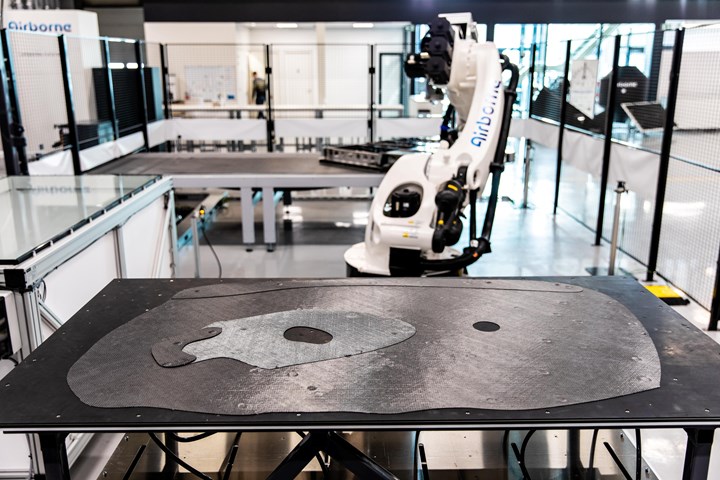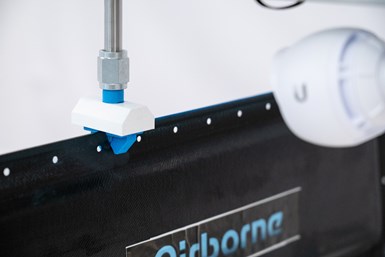CAMX 2022 exhibit preview: Airborne
Airborne’s Automated Ply Placement and Automated Edge Sealing technologies aim to ensure constant, repeatable and flexible production of complex composite products.
Converting composite materials into tailored blank laminates or preforms is a crucial but vulnerable step of making composite parts. With the Airborne (The Hague, Netherlands) Automated Ply Placement technology, it is said a designer can use all materials available on the market — prepregs, dry fiber or thermoplastics — to create an optimal laminate with freeform edges and patches or cutouts and design for high-performance, highly accurate laminates.
Automated Ply Placement offers users several benefits. First, the layup process is fully automated and integrated in one system — cutting, inspection, placement and storage of plies and finished laminates. Downstream processes such as press/hot drape forming, trimming, inspection or placement into the mold can also be integrated, Airborne says. Second, designs can be created that are not feasible or are difficult to manufacture with other technologies, opening a whole spectrum of possibilities for the creation of more competitive products. The system is also said to be ready to use future materials that are coming to the market, such as recycled, bio-based or novel material forms.
Airborne’s technology can be used with unidirectional (UD) tapes or textiles (fabric, noncrimp fabrics/NCFs), film, core material, metal layers and more. The technology is able to handle materials on roll as well as sheet materials. Sandwich laminates are also possible.
The Automated Ply System cuts the materials into the right ply shapes, stores it in the buffer station and creates the laminate with advanced, robotic ply placement that includes spot-welding to stabilize the laminate. Plies are accurately placed thanks to advanced robot control and fully inspected by vision, according to the company. The technology provides 100% net-shape laminates with no trimming needed. In addition, the system can be used in a user friendly way with Airborne’s Automated Programming software, avoiding the need for human robot programming. The design, material and operational input is automatically translated to the right machine code and process settings on the fly.
Airborne’s Automated Edge Sealing system is another technology aiming to ensure constant production quality while maintaining low costs. The flexible, automated programming of complex shapes makes it possible to seal a multitude of parts, the company says. Airborne’s software takes the design and material input and translates this via an advanced algorithm into the correct robot motions and process parameter settings. Ultimately, the technology is said to reduce manual labor and cost of quality control, enable easy adaption of production rate, allow for high product mix with short turnover times and decrease worker exposure to chemical substances.
Other benefits include high productivity, reduced resin use and a repeatable, environmentally friendly process.
Related Content
-
Concentrated smooth dispersion simplifies electrical conductivity applications
CAMX 2024: Total Resin presents Total Nanotüp, a concentrated dispersion of carbon nanotubes in a bifunctional reactive monomer for polyester, vinyl ester, melamine and acrylic resins.
-
High-strength, nondestructive adhesive-bonded fasteners
CAMX 2023: Rotaloc bonding fasteners come in a variety of baseplate styles, threads, sizes and materials for high-strength, nondestructive bonding with fiber-reinforced composites and thermoset/thermoformed plastics.
-
Highly tunable, woven lattice reinforcements target automotive structures
CAMX 2023: Startup Weav3D will be demonstrating its two collaborative automotive demonstrator parts and present two conference papers.

















